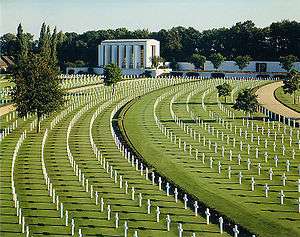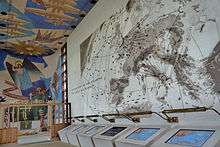Cambridge American Cemetery and Memorial
Cambridge American Cemetery and Memorial is a World War II American military war grave cemetery, located between the villages of Coton and Madingley, 7 km (4.3 mi) north-west of Cambridge, England. The cemetery, dedicated in 1956, contains 3,811 American war dead and covers 30.5 acres (12.3 ha). Cambridge American Cemetery is one of 26 overseas military cemeteries administered by the American Battle Monuments Commission (ABMC).[1]
| Cambridge American Cemetery and Memorial | |
|---|---|
| American Battle Monuments Commission | |
 Cambridge American Cemetery headstones, with the memorial building behind. | |
| Used for those deceased 1941–1945 | |
| Established | 1943 |
| Location | 52.2161°N 0.0538°E near Cambridge, England |
| Designed by | Perry, Shaw, Hepburn and Dean (architects) Olmsted Brothers (landscaping) |
| Total burials | 3,812 |
Unknowns | 24 |
| Burials by war | |
World War II 3,812 | |
| Statistics source: American Battle Monuments Commission | |
The cemetery
The University of Cambridge[2][3] donated 30.5 acres of land on the north slope of Madingley Hill to the American military forces for use as a temporary cemetery during World War II in 1943. Following the war, the American Battle Monuments Commission selected Cambridge as the site for America's permanent World War II cemetery and war memorial in the United Kingdom. America's war dead from three temporary cemeteries in the British Isles were consolidated into the Cambridge cemetery during an extensive cemetery construction project, and simultaneously the US Government repatriated approximately 58% of the existing war dead at the request of the surviving family members. Cambridge American Cemetery and Memorial was dedicated on 16 July 1956.[2]
The cemetery contains 3,809 headstones, with the remains of 3,812 servicemen,[4] including airmen who died over Europe and sailors from North Atlantic convoys. The inscribed Wall of the Missing includes four representative statues of servicemen, sculpted by American artist Wheeler Williams. The wall records the names of 5,127 missing servicemen, most of whom died in the Battle of the Atlantic or in the strategic air bombardment of northwest Europe.[5]

Besides personnel of the United States armed forces there are also buried 18 members of the British Commonwealth armed services, who were American citizens serving chiefly in the Royal Air Force and Air Transport Auxiliary, besides an officer of the Royal Canadian Air Force and another of the British Royal Armoured Corps, whose graves are registered and maintained by the Commonwealth War Graves Commission.[6]
In May 2014 a new visitor centre opened, containing exhibits about some of those individuals interred or remembered at the cemetery, and the wider World War II campaigns in which they were involved.[3]
Notable burials and memorials
_-_NARA_-_6003746_(cropped).jpg)
- Vincent F. Harrington (1903–1943), US Representative and US Army Air Forces officer
- John Martin Howard (1917-1942), US Navy officer - (memorial - buried at sea)
- Joseph P. Kennedy, Jr. (1915–1944), eldest son of Joseph P. Kennedy, Sr. and Rose Fitzgerald (memorial – lost at sea)
- Glenn Miller (1904–1944), jazz bandleader and trombonist (memorial – lost at sea)
- Leon Vance (1916–1944), US Army Air Forces pilot and Medal of Honor recipient (memorial – lost at sea)
- Three of the crew of USAAF B-17 Flying Fortress Mi Amigo, which crashed in Sheffield, killing all 10 crew (seven later repatriated to the US)
The memorial (including chapel)
The memorial building is 85 ft (26 m) long, 30 ft (9.1 m) wide and 28 ft (8.5 m) high; it is made of Portland stone; the doors of teak are embellished with relief models of World War II military equipment. The memorial is separated into a large museum room with a small chapel at the far end from the doors. A great map on the wall shows schematically the air sorties flown from East Anglia, together with convoys across the North Atlantic and other actions in the war. The wall and roof has a mosaic of angels and ghostly aircraft.[7]
Design
The architects of the site plan were Perry, Shaw, Hepburn and Dean, while the landscape architecture was arranged by the Olmsted Brothers company.[7]
Chapel gallery
 Chapel interior
Chapel interior- Showing the air sorties from East Anglia
 Design on the ceiling of the chapel
Design on the ceiling of the chapel Altar in the chapel
Altar in the chapel
References
- American Battle Monuments Commission. "Cambridge American Cemetery". abmc.gov. Retrieved 22 February 2019.
- "Cambridge American Cemetery and Memorial" (PDF). American Battle Monuments Commission. Archived from the original (PDF) on 5 August 2014. Retrieved 15 September 2014.
- "American Battle Monuments Commission, Cambridge Cemetery". Retrieved 15 September 2014.
- The difference in numbers is accounted for by the fact that one headstone is over a grave with two servicemen, who could not be separately identified, and another is over a grave with three servicemen for the same reason.
- "American Battle Monuments Commission, Cambridge Cemetery". Archived from the original on 27 May 2010. Retrieved 12 August 2010.
- CWGC Cemetery Report.
- "Cambridge American Cemetery and Memorial" (PDF). American Battle Monuments Commission. Archived from the original (PDF) on 19 November 2010. Retrieved 29 October 2010.
- Sledge, Michael (2005). Soldier Dead: How We Recover, Identify, Bury, and Honor Our Military Fallen. New York: Columbia University Press. pp. 207, 210. ISBN 9780231509374. OCLC 60527603.
External links
| Wikimedia Commons has media related to Cambridge American Cemetery and Memorial. |
